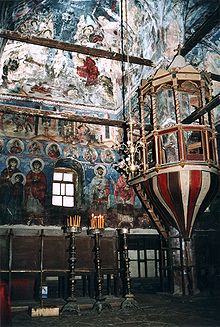- David Selenica
-
David Selenica or Selenicasi was an Albanian painter of the late 17th and the early 18th century. He is regarded as one of the most prominent figures of Albanian post-Byzantine icon painting.
Selenicasi, also known as David of Selenica was born in the late 17th century in Selenicë, a village in the region of Kolonjë.[1] He died in the mid-18th century near Korçë.
Contents
Works
In 1715 he painted frescoes in one of the chapels of the monastery of the Great Lavra, the first monastery built on Mount Athos.[2] From 1722 to 1726 David Selenica and his two disciples Kostandin and Kristo painted the murals, the frescoes and the basilica of the church of Saint Nicholas in Moscopole.[1] In 1727 he painted the murals and the frescoes of the church of Saint John the Baptist in Kastoria, and the church of Blessed Virgin Mary in Thessaloniki.[3]
Technique
In contrast to other painters of his era, Selenica uses bright colours in his paintings and icons.[1] Selenica combines elements of Byzantine art of the Paleologan era and Venetian school of art.[3]
Legacy
David Selenicasi's work influenced many of his contemporaries like Kostandin Shpataraku, the brothers Kostandin and Athanas Zografi and works of the early 19th century. He is regarded as the founder of a distinct national school of painters based in Korçë.[1]
His works are exhibited in the National Historical Museum of Albania in Tirana in the pavilion of icon painting and the National Museum of Medieval Art of Korçë.[4] Other works of David Selenicasi are found in several monasteries of Mount Athos.[5] In Moscopole seven of his murals have been preserved.
See also
- Venetian school
Sources
- ^ a b c d Popa, Theofan (1961) (in Albanian). Piktorët mesjetarë Shqiptarë. Ministry of Education and Culture. pp. 63–5. http://books.google.com/books?id=1thtAAAAIAAJ.
- ^ Studia Albanica. Studia Albanica. 37. University of Michigan, Academy of Sciences of Albania. 2004. pp. 65. http://books.google.com/books?id=lIRpAAAAMAAJ.
- ^ a b Pirovano, Carlo (2002) (in Italian). Percorsi del sacro: icone dai musei albanesi. Electa. pp. 37–8, 67. ISBN 8843582917. http://books.google.com/books?id=UmIVAQAAIAAJ.
- ^ "National Museum of Medieval Art of Korçë". http://www.korca.cchnet.it/the-history/the-history/view?set_language=en. Retrieved 1 April 2010.
- ^ Ndarurinze, Renate (2008) (in German). Albanien entdecken: Auf den Spuren Skanderbegs. Trescher Verlag. pp. 109. ISBN 3897941252. http://books.google.com/books?id=_ONjVWRhAKcC.
Categories:- 17th-century births
- 18th-century deaths
- People from Kolonjë District
- Albanian painters
Wikimedia Foundation. 2010.

